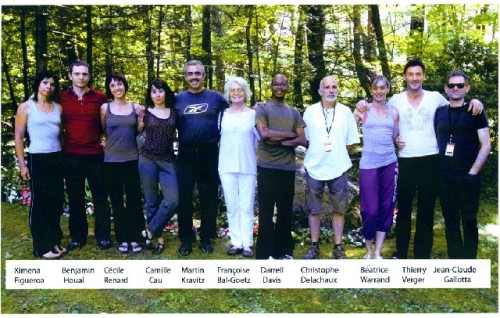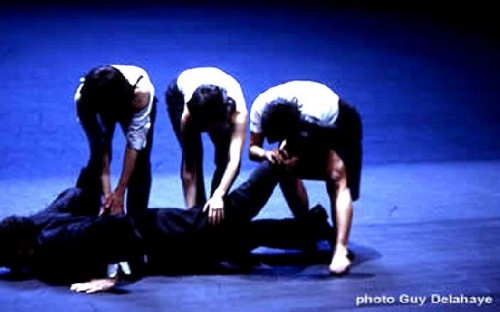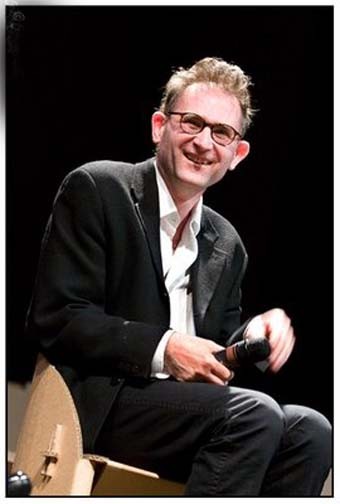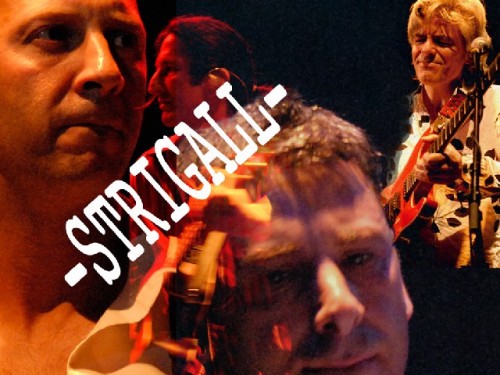Groupe Emile Dubois at Jacob's Pillow
Des Gens qui dansent in US Premiere
By: Charles Giuliano - Jul 18, 2009
Des Gens qui dansent
Groupe Emile Dubois
Centre Choregraphique National de Grenoble- Jean-Claude Gallota
Choreographer, Jean-Claude Galotta; Choreographer's Assistant, Mathilde Altaraz; Dramatist, Claude-Henri Buffard; Music, Strigall; Lighting, Marie-Christine Soma; Costumes, Jacques Schiotto and Marion Mercier; Costumes Construction, Marion Mercier and Anne Jonathan; Trainers, Mathilde Altaraz and Darrell Davis; Dancers, Francoise Bal-Goetz, Camille Cau, Darrell Davis, Christophe Delachaux, Ximena Figueroa, Jean-Claude Gallotta, Benjamin Houal, Martin Krtavitz, Cecile Renard, Thierry Verger, Beatrice Warrand; Lighting Manager, Frederic Willhelm; Sound Manager; Antoine Strippoli; Dress Manager, Anne Jonathan; Tour Administrator, Marie-Pierre Paillard.
Jacob's Pillow Dance
Ted Shawn Theatre
Becket, Mass.
July 15-19, 2009
In a rare American tour, Groupe Emile Dubois, which was co-founded in 1979 by Jean-Claude Gallota and Mathilde Altaraz, is presenting the American premiere of "Des Gens qui dansent (Some People Who Dance)." It is the final segment of a trilogy that includes "99 Duos" (2002) and "Trois Generations" (2004).
The mandate of the company named for a fictional everyman, Emile Dubois, a John Doe, who may or not have lived, is a new definition of genre as a celebration of the ordinary in everyday life. In art the notion may be found in the "Card Players" of Caravaggio or the tavern scenes in the Golden Age of Dutch painting. It is reflected in the realism of the novels of the 19th century French authors Flaubert, Balzac, and Zola, or the novels of Charles Dickens. Charles Baudelaire wrote in praise of Constantin Guys as "The Painter of Modern Life." The ersatz mundane of street life was captured by Henri de Toulouse Lautrec and Edouard Manet. Compared to the high art and kitsch displayed in the Salon their work was viewed as shocking and vulgar.
Experiencing this miraculous company which is based at the Maison de la Culture de Grenoble, France brought freshness and vitality to the notion of contemporary dance. It triumphed not in the art of the Spectacle as defined by the Situationist, Guy Debord, but in its focus on the ordinary. To make poetry not through the high art of ballet, its classical movement and form, but to display the mundane, allowing us to see and feel the invisible aspects of the every day in the passages of life.
The curtain opened on a bare stage. We could see the textures of the venerable barn at the back of the stage. There were the barres which dancers use to brace themselves in the studio. The lighting was primarily ambient and subdued. There would be minor adjustments during the performance but no attempt to literally follow the sequences of the choreography.
In a line the ten dancers faced us and each made a brief statement using a mix of French, Spanish and English. They were dressed in variations of street clothes which loosely allowed us to establish their individual personas. There was a range of ages, body types, races, and degree of difficulty and training. We caught our first glimpses of the Tall Man, Thierry Verger, in a suit and tie, seemingly paired with the stunning and spectacular, Tall Woman, Beatrice Warrand, in a dress. We wondered if the older man, Christophe Delachaux, might be Islamic because of a white, North African scull cap. There was the older woman, Francoise Bal-Goetz, in a sensible dress, and a bald, middle aged black man with glasses in a suit.
The ten dancers assumed a crouching position with arms extended shaking their hands in a fluttering gesture that evoked Minstrels or African dance. It conveyed a playful comic spirit. The evening would end with a similar line and display of movement.
What came in between was choreography that was casual, diverse, full of surprise and invention. There seemed to be none of the clichés that we have come to expect of contemporary dance. This company is truly unique and there was the sense that we were seeing something very original. We came to expect the unexpected. For instance, when the barres dropped off the walls with a loud thud.
There was a constant change and evolution of the movement, patterns, and lines across the stage. Every combination was explored, from the entire ensemble, to pas de deux, pas de trios, and pas de quatre. In that latter configuration, for example, there was a sequence where the Tall Man dances with three women. It ends with him stacking them one on top of the other prone on the floor. He then lies down beside them and drapes an arm over them in seeming possession/ conquest.
The choreographer, Jean Claude-Gallota, was a persona in addition to the ten dancers. He also had brief moments of dance movement, flourishes and garnishes really, but he was primarily a narrator, singer and mysterious black clad persona with shades. He was a thread who stitched through a tapestry of incidents.
It is tempting to say that the dance was about something. That it connected as a narrative. Rather than conveying a cohesive story it evoked the avant-garde notion of Sontag's "Against Interpretation." Or Billie Holiday in a poignant ballad telling her lover "Don't Explain." To attempt to reduce the dance to a story line and narrative would deplete its affect and poetic impact. Rather than state what it means, a conceit at best, better to discuss its whatness and whyness as an itness. Just see and absorb the experience and reflect on the hidden poetry of our day to day lives.
The mix of electronic music by the group Strigall was hypnotic and superbly understated. At times it was a bare whisper and even disappeared in favor of hushed, barely audible gibberish. The human voice was more a sound than a song. In a somewhat comic pairing Martin Kravitz and Christophe Delachaux oddly interacted even butting or touching heads. They would break into passages of ersatz opera. We wondered just what they were sharing that brought these older men together. It was visually engaging but like much of the dance a non sequitur.
The music was so perfect and evocative that it made one ask which came first, the narrative and intentionality of the dance, or the music? Was there first a score that the dance was adapted to? Or did the idea of the dance exist and the music was arranged and adapted to the theme? Some research revealed that Antoine Stripolli, the composer and leader of Strigall, has been collaborating with Gallotta for some time. While the music was primarily electronic, employing a drum machine, toward the end of the evening there was a passage with guitars that evoked the rich, somber, full bodied, acoustic guitar sound of Ry Cooder or Leo Kottke. On line I found that Strigall has released three CDs.
The originality of the company largely derives from the diversity and multi disciplinary background of Gallota. He was studying the fine arts when, at the age of 20, with no prior training, he began to create informal dances in the streets, artist lofts, and other settings. He is also a writer and film maker. All of these elements and influences converge to define his vision. Not having a formal background in dance makes him open to working with individuals with a range of skills and assets. It is a matter of how they fit into an ambiance. They are allowed to be themselves. This results in a naturalism with a diverse blend of skills and personalities.
At the high end of the company Beatrice Warrand most commands our attention. She is closest to the paradigm of dance in both body type, tall and taut, as well as expressive skills, and classical training. She is used well but not isolated as a star overshadowing the rest of the company. Christophe Delachaux is also very interesting with unique character and personality. Gallotta features and highlights him effectively. He is the most fleshed out persona of the company. We feel we know him. The moments with Darrell Davis are shocking and riveting. He has well trained movements that catch out attention.
While there is something going on at center stage the other dancers come and go. At times they sit in chairs on the periphery and just observe. In one element Delachaux arrived on stage with a trombone and sat with Gallotta who was droning into the microphone. We wonder what he will play but it is more a gesture and incident than a passage of music.
Rather late in the dance a screen is dropped and in English and French Delachaux informs us that we will see a video of Henry Miller. The author, on his death bed, muses on whether there is a supreme being as he is about to find out. He thinks not. Miller also apologies for being primarily interested in his own wonderful life and writing so much about himself. It is a brief and poignant vignette that informs the end of the dance. The issue of passages, youth vs. age, is accented in a pas de deux between the older woman, Francoise Bal-Goetz, and the young dancer, Camille Cau.
We left the performance sorting out many ideas and impressions. Because it was so different there is a challenge to convey what we experienced. Mostly I have focused on the newness. Think of contemporary dance, and then forget that, try again. Let us hope that it will not be decades before we again experience this fascinating company. They have taken the ordinary and reformed it as the extraordinary.
Looking ahead at Jacob's Pillow
David Roussève/ REALITY
Doris Duke Theatre
Wednesday, July 15 – Saturday, July 18, 8:15pm
Saturday, July 18, 2:15pm
Sunday, July 19, 5pm
After a ten-year break from choreographing for his own company, award-winning dancemaker, filmmaker, writer, and performer David Roussève makes a triumphant return to the stage with David Roussève/REALITY. His newest work, Saudade, deals with the concept of "bittersweet" in a production that chronicles the story of southern African-Americans to the sound of Portuguese blues, fado. A multicultural cast illuminates a mosaic of movement, video effects, and monologues, performed by Roussève himself, spanning from slavery to Hurricane Katrina. Traditional dance forms from Indonesia , West Africa, and India merge with contemporary techniques in this new work, which premieres in February 2009. Tickets $33 adult, $30 senior, student, child, $29 subscriber.
Merce Cunningham Dance Company
Ted Shawn Theatre
Wednesday, July 22 – Saturday, July 25, 8pm
Saturday, July 25 – Sunday, July 26, 2pm
Widely recognized as the world's greatest living choreographer, Merce Cunningham's accolades range from countless honorary doctorates to the Praemium Imperiale in Tokyo (2005), the National Medal of Arts (1990), and Kennedy Center Honors (1985). Jacob's Pillow celebrates his 90th birthday and a relationship that began with the company's first Pillow performances in 1955. His revolutionary approach to space, time, music, and technology is honored with a retrospective of masterworks. The program includes Sounddance (1975), described by Cunningham as "space observed under a microscope," CRWDSPCR (1993) a work of constant motion, and eyeSpace (2006) which invites audiences to listen to individualized scores, using provided iPod Shuffles. Tickets $58 adult, $53 senior, student and child, $52 subscriber. $10 Sunday youth matinée tickets (must be accompanied by an adult).
Jason Samuels Smith and A.C.G.I. (Anybody Can Get It)
Doris Duke Theatre
Wednesday, July 22 – Saturday, July 25, and Wednesday, July 29 – Saturday, August 1, 8:15pm
Saturdays, July 25 and August 1, 2:15pm
Sundays, July 26 and August 2, 5pm
A tap prodigy, Jason Samuels Smith was 15 years old when he was cast as Savion Glover's understudy and a principal dancer in Broadway's Bring in 'da Noise, Bring in 'da Funk. He has since gone on to become an Emmy and American Choreography Award-winner, television and feature film performer, director, and choreographer, and also is widely known for appearing as a featured guest artist on the FOX television show So You Think You Can Dance. After performing as an original member of Glover's Not Your Ordinary Tappers, he formed his own company of experienced tap soloists, A.C.G.I. (Anybody Can Get It). This two-week engagement pays homage to the history of tap while also experimenting in contemporary styles, and every performance features live music. Tickets $33 adult, $30 senior, student, child, $29 subscriber. $10 Sunday youth matinée tickets for July 26 only (must be accompanied by an adult)
.
13th Annual Community Day
Sunday, July 26, 10am – 1pm
The Pillow transforms into a dance party for all ages with free, family-friendly programming during its annual Community Day (rain or shine). Everyone is welcome to attend free performances, dance workshops, arts and crafts activities, book readings for children, game, and more. Community Day is free and open to the public.
Les Grands Ballets Canadiens de Montréal
Ted Shawn Theatre
Wednesday, July 29 – Saturday, August 1, 8pm
Saturday, August 1 – Sunday, August 2, 2pm
CANADA
Last seen at the Pillow in 2005, Canadian contemporary ballet company Les Grands Ballets Canadiens de Montréal recently celebrated its 50th anniversary and is known for its diverse, adventurous repertoire and collaborations with top choreographers including Ji?à Kylián, Mats Ek, Nacho Duato, and Ohad Naharin. Under the direction of Gradimir Pankov, the company performs two very different works, both by Italian choreographer Mauro Bigonzetti. Four Seasons is set to Vivaldi's classic score of the same name, and Cantata pays homage to Mediterranean culture and tradition with original and folk music from Southern Italy . Tickets $58 adult, $53 senior, student and child, $52 subscriber.
Rennie Harris Puremovement
Ted Shawn Theatre
Wednesday, August 5 – Saturday, August 8, 8pm
Saturday, August 8 – Sunday, August 9, 2pm
After directing the Cultural Traditions program at The School at Jacob's Pillow (June 29 – July 12), international hip-hop ambassador Rennie Harris returns to perform as part of the Festival. Harris, lauded by The New York Times as "a central figure in hip-hop," and the dancers of Puremovement have a singular style, combining a variety of genres including popping, locking, electric boogaloo, and more. They perform signature works such as Students of the Asphalt Jungle, Continuum, Breath, and March of the Antmen to a medley of original and mixed music, including live bucket drumming. Tickets $58 adult, $53 senior, student and child, $52 subscriber.
Jacinta Vlach/ Liberation Dance Theater
Doris Duke Theatre
Wednesday, August 5 – Saturday, August 8, 8:15pm
Saturday, August 8, 2:15pm
Sunday, August 9, 5pm
Provocative territory and powerful dancing are the signatures of San Francisco-based Liberation Dance Theater. Jacinta Vlach, a former dancer with nathantrice/ RITUALS, Robert Moses' Kin Dance Company, and Philadanco, merges modern dance and urban movement styles in her choreographic commentaries on race, culture and identity. This powerful program includes Abjection in America, set to a score of Latin fusion music and audio excerpts from comedians Richard Pryor and John Leguizamo. Other works to be announced. (contains strong language) Tickets $33 adult, $30 senior, student, child, $29 subscriber.
Doug Varone and Dancers
Ted Shawn Theatre
Wednesday, August 12 – Saturday, August 15, 8pm
Saturday, August 15 – Sunday, August 16, 2pm
New York choreographer Doug Varone is acclaimed for intelligent and lushly kinetic movement that appeals to both the mind and the heart. He has received numerous honors throughout his career, including two New York Dance and Performance (Bessie) Awards for Sustained Achievement in Choreography, and for his 2006 work Boats Leaving. A veteran of the José Limón and Lar Lubovitch companies, Varone founded his own company in 1986. They perform a varied program including Lux, set to Philip Glass' The Light, and described by The Washington Post as "the kind of dancing I might dream about, loose and sweeping in a spirit of exultation." Other works to be announced. Tickets $58 adult, $53 senior, student and child, $52 subscriber.
Rubberbandance Group
Doris Duke Theatre
Wednesday, August 12 – Saturday, August 15, 8:15pm
Saturday, August 15, 2:15pm
Sunday, August 16, 5pm
CANADA
In dancer/choreographer Victor Quijada's newest work, Punto Ciego (Blind Spot), Rubberbandance takes movement to new heights in a work filled with ballet, contemporary, hip-hop, spoken word, and video. The company interacts with audiences through multimedia technology and subtle storytelling, drawing them into a humorous, poignant world of six characters that break boundaries, mix realities and entertain. Rubberbandance, founded in 2002 and led by Quijada and co-artistic director Anne Plamondon, has toured throughout Europe, North America, and Japan , and last performed at the Pillow in 2006. Tickets $33 adult, $30 senior, student, child, $29 subscriber.
Pacific Northwest Ballet
Ted Shawn Theatre
Wednesday, August 19 – Saturday, August 22, 8pm
Saturday, August 22 – Sunday, August 23, 2pm
The work of the late Ulysses Dove, a former member of Alvin Ailey American Dance Theater, seamlessly combines speed and attack with daring sensuality, emotional strength, and power. In this exclusive Pillow engagement, the dancers of Pacific Northwest Ballet, under the direction of Peter Boal, perform an all-Dove program of Vespers to Mikel Rouse's percussive score; Red Angels, which featured Boal in the original New York City Ballet cast; and Dancing on the Front Porch of Heaven with music by Arvo Pärt. Tickets $58 adult, $53 senior, student, child, $52 subscriber. $10 Sunday youth matinée tickets for August 22 only (must be accompanied by an adult)
.
Kidd Pivot
Doris Duke Theatre
Wednesday, August 19 – Saturday, August 22, 8:15pm
Saturday, August 15, 2:15pm
Sunday, August 23, 5pm
CANADA
Crystal Pite, international choreographer and artistic director of Vancouver-based Kidd Pivot, explores movement to the fullest in her evening-length work Lost Action. A former dancer with the Frankfurt Ballet under the direction of William Forsythe, Pite's wit, rigor and ultra-kinetic approach interact with a diverse soundscape by longtime collaborator Owen Belton and features everything from choral melody to ukulele and spoken word. This physical analysis of dance and the ephemeral body becomes a metaphor for life and loss. Pite will perform with her company, a rare occurrence. Tickets $33 adult, $30 senior, student, child, $29 subscriber.
A Jazz Happening
Sunday, August 23, 8 pm
Benefit Event for The School at Jacob's Pillow
This one-night-only event features dancers of the Jazz/Musical Theatre Dance program, performing alongside Broadway stars after three weeks of intense study and preparation at The School at Jacob's Pillow. Directed by Broadway's Chet Walker, A Jazz Happening includes original choreography by the Jazz/Musical Theatre Dance artist faculty and live music by an onstage jazz band. Former guest performers have included Donna McKechnie, Andrea McArdle, Stephen Bogardus, and Terri Klausner, and this season's event will feature an all-new program and cast. Proceeds benefit The School at Jacob's Pillow; $100 level tickets include a reception with the performers. Tickets $100 and $60.
Ballet Hispanico
Ted Shawn Theatre
Wednesday, August 26 – Saturday, August 29, 8pm
Saturday, August 29 – Sunday, August 30, 2pm
According to The New York Times, "the Latin-American experience at last has a voice in the feisty, elegant dancing of Ballet Hispanico." Since 1970, this company has fused Latin, classical ballet and modern dance, creating a style all its own. This engagement will honor Tina Ramirez, who steps down as artistic director this year and first performed at the Pillow as a teenager in 1948. The program includes excerpts from Club Havana, in which the rhythms of the Rumba, Mambo, and Cha Cha are brought to life by Cuban choreographer, and former Ballet Hispanico dancer, Pedro Ruiz. Tickets $58 adult, $53 senior, student, child, $52 subscriber.
Doug Elkins and Friends' Fräulein Maria
Doris Duke Theatre
Wednesday, August 26 – Saturday, August 29, 8:15pm
Saturday, August 29, 2:15pm
Sunday, August 30, 5pm
The New Yorker calls Doug Elkins and Friends' Fräulein Maria "a jewel of choreographic invention and comic subtlety" and The New York Times hails it as "ceaselessly brilliant and often hilarious." This rollicking, deconstructed version of Rodgers and Hammerstein's The Sound of Music has been lauded by critics and audiences alike through numerous sold-out runs in New York City . Vaudeville gags, astute references to the choreography of Martha Graham, José Limón and others, and a multitude of social dance moves are set to the original film soundtrack, enveloping audiences in Elkins' imagination. Tickets $33 adult, $30 senior, student, child, $29 subscriber.






